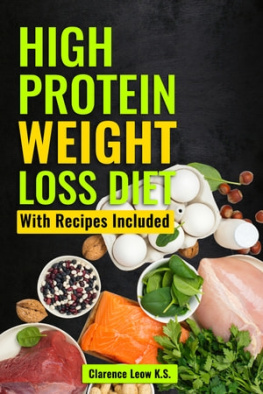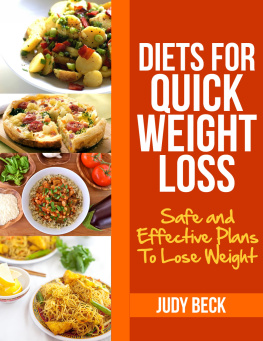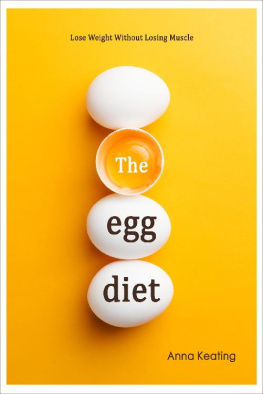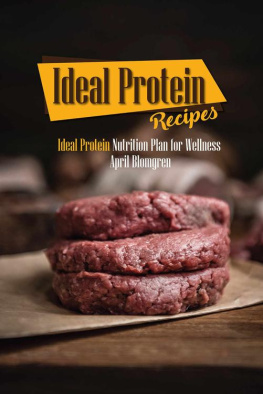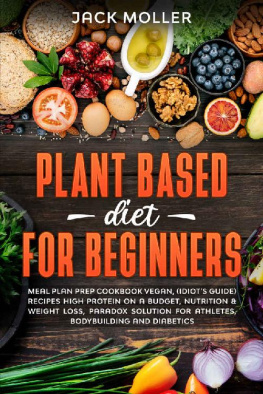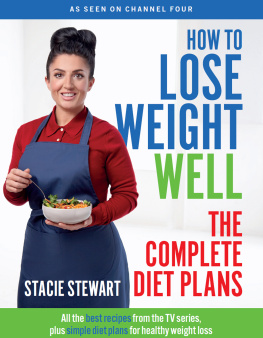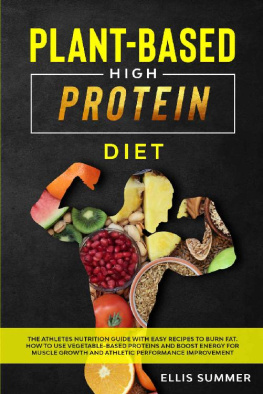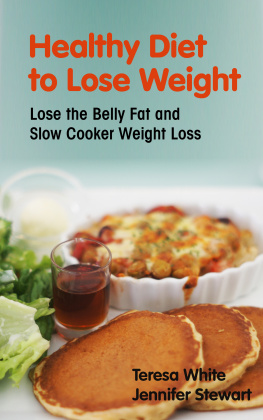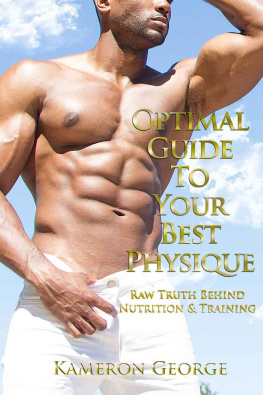HIGH PROTEIN WEIGHT LOSS DIET
WITH RECIPES INCLUDED
[Clarence Leow K.S.]
Copyright 2022 Clarence Leow K.S.
All rights reserved.
Table of Contents
INTRODUCTION
W hen we think of strategies to reduce weight, the first thing that springs to mind is exercise! Physical activities are typically suggested to those who want to lose weight rapidly. Still, new research has revealed that your food is more crucial in your weight reduction journey than how much exercise you do each day. Working out hard at the gym certainly benefits your health, but you must also keep a close eye on your daily food! Therefore, the first and most important guideline of any weight reduction strategy is to set realistic objectives for yourself. For example, you should not expect to drop 10 kg weekly since it is simply not achievable with food and exercise alone! As a result, always begin your weight reduction journey with achievable goals. Next, create a schedule for your daily activities, including eating, workout, and sleep schedules.
Weight lifting, according to experts, boosts your hunger, causing you to eat more. So, while exercise is vital, nutrition is more important since eating the appropriate foods will keep you satisfied for a long period. While reducing weight is tough for many individuals, maintaining a weight loss is even more difficult. Most people who lose significant weight regain it two to three years later. This makes it increasingly difficult to reduce weight over time.
A slower rate of calorie expenditure may also make it simpler to regain weight when returning to a more typical diet. Extremely low-calorie diets and quick weight reduction are discouraged for these reasons. Long-term lifestyle adjustments are required to boost the likelihood of long-term weight loss success. Weight reduction to a healthy weight for a person's height can positively impact health. All examples are lower cholesterol and blood sugar levels, less stress on bones and joints, lower blood pressure, and less effort for the heart. It is critical to sustain weight loss to get long-term health advantages. Keeping excess weight off requires effort and dedication, just as reducing weight does. Weight loss objectives are achieved through dietary, eating, and activity adjustments. People turn to bariatric surgery in severe cases.
CHAPTER-1
What Is A High-Protein Diet?
A high-protein diet emphasizes consuming enough Protein perhaps more than you are used to receiving as the primary emphasis of your eating habits. Eggs, meat, shellfish, beans, and dairy products are all high in Protein. These foods are high in nutrients in general, not only Protein. That is to say, and a high-protein diet is simultaneously a high-nutrition one. Increasing Protein can help you lose weight since Protein can suppress your appetite. It also provides a sufficient supply of the basic elements required to sustain your muscles and metabolism, ensuring you burn calories at an adequate pace. People who wish to grow muscle must consume more Protein than is normally suggested. Current guidelines, known as the RDA or recommended dietary allowance, are intended for "healthy persons" and to avoid malnutrition; they are not intended to assist grow muscle mass or treat medical disorders like type 2 diabetes. Protein-rich diets may benefit the treatment and prevention of type 2 diabetes, metabolic syndrome, and maybe even heart disease. Higher protein consumption also helps to avoid sarcopenia, which is a loss of muscle mass that can develop as you age, and osteoporosis, a related disorder that is a loss of bone mass. It is in charge of various critical processes in the body, including hormone production, enzyme production, and cell repair and maintenance. High-protein diets promote consuming more Protein and fewer carbs and fat to lose weight, increase energy, and improve athletic performance.
Protein-rich diets reduce appetite, promote satiety, raise metabolic rate, and retain muscle mass. Regarding diets, however, one size does not fit all, and what works for one individual might not work for another. A high-protein diet frequently implies a reduction in carbs. A healthy strategy is a balanced diet with around 50% carbohydrates, 20% protein, and 30% fat. Most individuals can maintain a high-protein diet by consuming meat, fish, dairy products, beans and lentils, eggs, and protein-rich plants like asparagus and spinach. People on this diet will frequently choose to restrict their carbohydrate intake, which may include avoiding highly processed meals, bread and other baked goods, sugar, and white pasta and rice. The Atkins diet is one of the most well-known high-protein diet programs. A person can, however, increase their protein consumption without changing their intake of other dietary categories. This book explains how to consume a high-protein diet, what foods to include and omit, and the potential negative effects of following this diet.
Foods with a high protein content are the best choices for high-protein diets. A food's protein percentage shows how much Protein it has per calorie. Meals with high Protein and low fat and carbohydrate content are ranked higher, as are low-fat, low-carb foods with high fiber content. Foods containing Protein in the intermediate range can help you maintain weight and muscle mass. Going a bit higher over 30 or 35% may aid in weight loss. Conversely, foods with a lower protein % may cause weight gain.
In contrast, foods with a higher protein percentage may be appropriate alternatives for someone serious about losing body fat and becoming lean and fit. Fortunately, most high-protein meals are tasty and abundant in vitamins and minerals. So if you consume mostly the items listed above, you are on your way to eating a healthy, protein-rich diet.
Remember that while non-starchy veggies have a high protein percentage, they do not provide you with the overall Protein, calories, or minerals required. Base your meals on a protein source, whether animal or plant-based, and include high-protein-percentage veggies for a little additional boost of amino acids, the Protein's building blocks. Just enough fat to make your dishes tasty and full. This method will ensure that the total protein % of your meals remains high. For example, extra egg whites can be added to scrambled eggs or omelets. Replace lower protein snacks like almonds and cheese with higher protein alternatives like lupini beans, sugar-free jerky, or cold cuts. Include items with more than 35% protein in your diet. Choose high-protein meals like shrimp, chicken breasts, and lean cuts of meat. Substitute low-fat cheese or Greek yogurt for higher-fat cheese and yogurt. Lower-fat versions have more Protein per calorie due to greater protein percentages.
Although we prefer to acquire most of our Protein from whole foods, protein powders may be a component of a balanced, high-protein diet. If you prioritize the items on our list of the top high-protein foods, you may not need protein powders. However, if you fall short of your daily protein goals, protein powders are a simple and quick method to supplement your diet. Furthermore, protein powders may be used to make high-protein versions of your favorite sweets, low-carb bread, or smoothies. If you use protein powders, be sure they don't contain additions like sweeteners, maltodextrin, seed oils, or fillers. You may pick between animal and plant protein powders depending on your taste, preferences, and carbohydrate objectives.
Lean meat and seafood have the greatest protein percentages and are low in carbohydrates and fat. Look for easy protein substitutes, such as snacking on lupini beans or venison jerky, adding two egg whites to your two full eggs in the morning, or adding additional meat, fish, dairy, or legumes to your meals. To get a more than 35% protein proportion, combine protein items with high-fiber veggies while avoiding excessive fat. Consider protein powders if you're having trouble meeting your protein objectives with entire meals.
Next page
